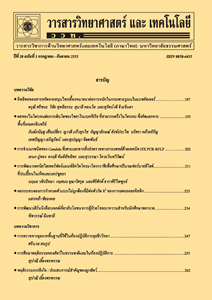Development of Learning Model for Emergency Care Using Community Based among Active Aging in Phayao Province
Main Article Content
Abstract
The action research aimed to develop learning model of a community-based regarding emergency care for active aging people in Phayao province. Two hundred and twenty-seven participants were; (1) supporter group, (2) practitioner group who were village health volunteers, active aging and representatives of people in the study area and, (3) community researchers and academic researchers. This research divided into three phases; (1) the first phase was a survey of the community context and community needs regarding emergency care, (2) the second phase was developed activities and intervention, and (3) the third phases was an evaluation. Data were collected by using documents observation, interview, test, forums, and after action reviews (AAR) technique. Data analysis were using content analysis, descriptive statistics, PNImodified and Friedman test. The results revealed that the models composed of three components as follows; (1) the community structure was a rural context, kinship, reciprocal people, and personal social capital who lived inner and outer community and strong cultural traditions, (2) three processes were participatory learning based on community needs, informal coordination and continuous intervention program which significantly affected self-efficacy and expected outcome at p-value < 0.001, and (3) community needs refection lead to be useful for themselves, advise to another group of people and also plan to establish activities strategies in order to caring emergency care among aging people. This research recommends that the stakeholders should be taken to establish policy, planning and activities for active aging in the area study and the similar area.
Article Details
References
World Health Organization, 2015, World Report on Ageing and Health, World Health Organization 2015, Luxembourg.
Prasartkul, P., Vapattanawong, P., Rittirong, J., Chuanwan, S., Kanchanachitra, M., Jaratsit, S., Thianlai, K., Aruntippaitun, S., Mathuam, J. and Sena, K. (Eds.), 2019, Situation of Elderly 2017, Institute for Population and Social Research, Deuan Tula Printing House, Bangkok. (in Thai)
Samsang, C. and Rattanapanya, S., 2019, A study of quality of life of in the elderly school, Thungknowpuang sub-district, Chiang Dao district, Chiang Mai province, Thai Sci. Technol. J. 27(5): 964-974. (in Thai)
World Health Organization, 2010, Global Status Report on Noncommunicable Diseases 2010, Available Source: https://www.who.int/nmh/publications/ncd_report2010/en, February 2, 2018.
Kanchanachitra, C., Podhisita, C., Archavanitkul, K., Pattaravanich, U., Siriratmongkon, K., Seangdung, H. and Jarassit, S., 2007, Thai Health 2007, Institute for Population and Social Research, Mahidol University, Nakhon Pathom.
Ullrich, F., Mueller, K.J. and Shambaugh-Miller, M., 2004, Emergency Medical Service Volunteer Personal in Nebraska: Workforce of the Present, Hope for the Future?, Nebraska Center for Rural Health Research, Nebraska.
Curtis, K., Ramsden, C., Shaban, R.Z., Fry, M. and Considine, J., 2019, Emergency and Trauma Care for Nurses and Paramedics, 3rd Ed., Elsevier, New South Wales.
Sajjathram, N., 2015, Health care model for quality of life among elderly, J. Soc. Sci. Human. Rajapruk Univ. 1(1): 43-53. (in Thai)
Department of Provincial Administration, Ministry of Interior, Statistic of Elderly 77 Provinces at December 31, 2017, Available Source: http://www.dop.go.th/ownload/knowledge/th1533055363-125_1.pdf, February 2, 2018.
Israel, B., Eng, E., Schulz, A.J. and Parkers, (Eds.), 2005, Methods in Community-based Participatory Research for Health, John Wiley & Sons, San Francisco, CA.
Phlainoi, S., 2004, From Action Research to Community Action Research, Faculty of Social Science and Humanities, Mahidol university, Nakhon Pathom. (in Thai)
Cohen, J., 1988, Statistical Power Analysis for Behavioral Science, 5th Ed., Lawrence Erlbaum, Hillsdale, NJ.
Ngamjarus, C. and Chongsuvivatwong, V., 2014, n4Studies: Sample Size and Power Calculations for iOS, Available Source: https://apps.apple.com/th/app/n4studies/id680516901, February 2, 2018.
Chaleekrua, T., 2010, Development of a Community-based Prehospital Care Management Model for Emergency Volunteers, Doctoral Dissertation, Mahidol University, Nakhron Pathom.
Wongwanich, S., 2005, Needs Assessment Research, Chulalongkhron University Publisher, Bangkok.
Bandura, A., 1977, Self-efficacy: Toward a unifying theory of behavior change, Psychol. Rev. 84: 191-25.
Chantawanich, S., 2005, Qualitative Methods, Chulalongkhron University Publishers, Bangkok.
Horne, M. and Costello, J., 2003, A public
health approach to health needs assessment at the interface of primary care and community development: Findings from an action research study, Prim. Health Care Res. Dev. 4: 340-352.
McDermott, L.R. and Weatherbie, K., 2012, Health promotores' perceptions of their communities' health needs, knowledge, and resource needs in Nicaragua, Public Health Nurs. 30: 94-105.
Chaingpiew, N., Boonchieng, W. and Aungwattama, S., 2018, Effects of participatory learning regarding stroke on knowledge and self-efficacy among village health volunteers, Nurs. J. 43(1): 87-98. (in Thai)
Collison, C. and Parcell, G., 2002, Learning to Fly, Capstone, Oxford.
Ambulance Victoria, 2020, Community & Partnerships, Available Source: https://www.ambulance.vic.gov.au/community/community-partnerships/auxiliaries, June 7, 2020.


